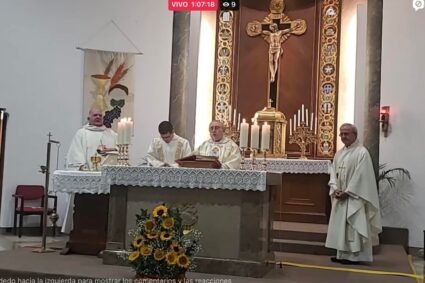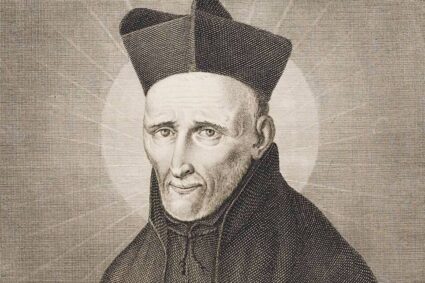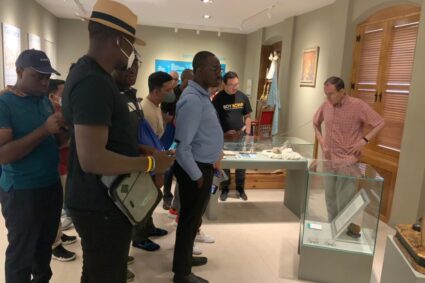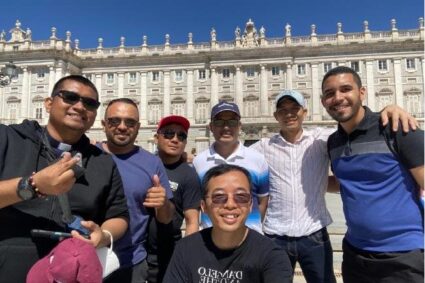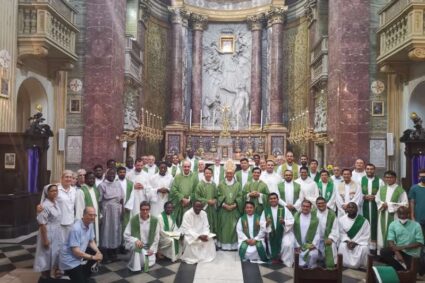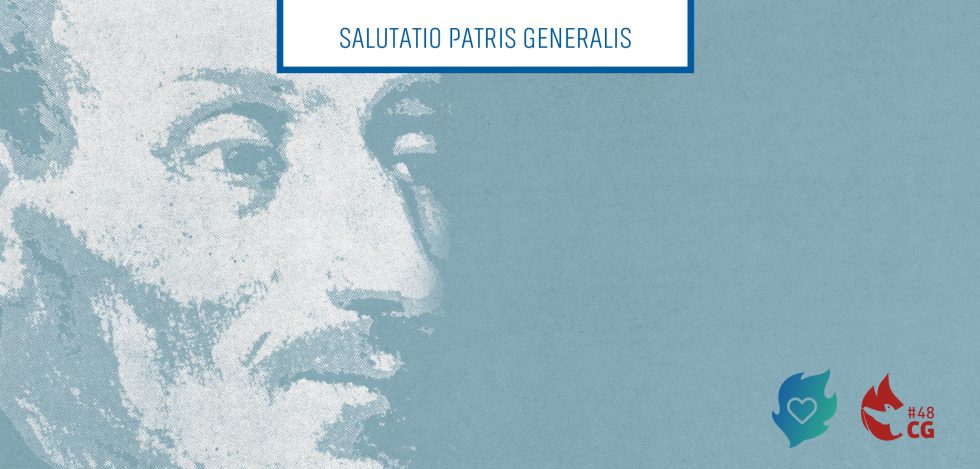
English / Castellano
Throughout the next year 2022 we will be living a new Piarist Vocational Year. It has been convened by the General Congregation in the framework of the celebration of the 400th anniversary of the constitution of the Pious Schools as a religious Order of solemn vows and the approval of the Constitutions written by Saint Joseph Calasanz. These anniversaries mark the consolidation of the Piarist religious and priestly vocation and deeply express its value and significance, which has been credited by so many years of history. I think that dedicating a year to deepening our vocation and finding new ways to sow it, promote it, welcome it and accompany it is something very valuable and necessary. Like everything we do, we want to live this Vocational Year in deep commitment to our Mission. We are for it and we call for it.
Ten years ago (in 2012) we also celebrated a Vocational Year. Like the current one, we also summon it and live inspired by the figure of Glicerio Landriani. Today we renew our thanksgiving to God for the venerable figure of this young Piarist, and as then, we continue to pray that his holiness and example of life may finally be recognized by the Church. May Glicerio Landriani, patron of the Calasanz Movement, continue to inspire everything we can live in this Vocational Year. Do not forget to visit the website that we have opened as a contribution to his canonization process.
I said that ten years ago we celebrated another Vocational Year. The fruits that were granted to us in that year were not few and had to do with many decisions regarding vocational teams, Vocation Ministry projects, the elaboration of materials, the growth in our awareness that Vocation Ministry to the Piarist religious life is an essential and priority task for all of us who are part of the Pious Schools. We have not convened this Vocational Year with the same objectives that we set ourselves ten years ago because, thank God, we are not in the same situation. We have walked quite a bit. The goal we set for ourselves is still valid, and that I could synthesize as a “doing things better”, but I believe that at this point in our process we must know how to name new goals and challenges. I would like to propose some, always in a synthetic way, because each of them would give for a specific letter, and some for a book. Let’s get started.
1. A spirituality of “construction of the Order”. You have heard it many times, but I want to continue to insist, because I think we are facing a central issue. The Pious Schools are not an end in themselves; they are an instrument of the Kingdom. But a very valuable instrument. Sometimes we forget that working for the construction of the Order and doing so in this aspect as essential as the incorporation of new young people who want to give their lives as Piarist religious and priests, is a formidable way to make that the Pious Schools can continue to offer their contribution to the promotion of the Kingdom of God.
It is not enough to give one’s life for the Mission. The Order must be built. If Calasanz had “only” given his life for the Mission, none of us would be here. Calasanz gave himself to the Mission and built the Order, because he understood that it was fundamental to the mission he assumed as a vocation. I believe that we are facing a spiritual challenge, a challenge that has to do with our way of understanding our vocation. Drawing all the consequences of this way of thinking becomes a very rich path of discernment and enrichment of our way of living, working and deciding. We are to make this “spirituality of building the Pious Schools” permeate all the facets of our lives. And we must do so for missionary reasons, because there is nothing more apostolic than calling people to be apostles.
2. Plurality and Priority. We are blessed by the precious gift of Piarist vocational plurality. Different ways of “living the Piarist” have been born, all of them valuable, all of them necessary, all of them complementary. Little by little we are giving name to these vocations, and we are consolidating them with the faithful and creative effort of those who live them. We thank God not only for the diversity, but also for the quality and significance of these new vocations, called to enrich the charismatic gift of Calasanz. But diversity is not at odds with the clarity that there is a specific vocation that must be proposed, worked on and understood as a priority. The Piarist religious vocation is based on the precious intuition of “giving everything”. Everything. It is a response of wholeness. It is not better or worse than other answers. All are necessary. But the basis is in the desire for wholeness. There is only one love, there is only one center, there is only one desire. And that is at the core of consecrated life and, without a doubt, in the soul of each of the young people who consider the Piarist religious vocation.
I would like to repeat something I have already said in another fraternal letter: God calls each one according to different vocations. And each one is fully valuable, because it is the one that God has inspired in one’s soul. But they are different. And religious life has always had, has and will have a plus, which is at its root: to give one’s whole life without reserving anything for myself; to love Christ and the mission totally, without other wonderful, good and holy loves; to trust fully, without seeking to be the master of one’s own life; to seek to live free for the mission, with no ties other than one’s own vocation and its consequences. The vocational decision to follow Christ is not the result of a choice in the “shopping” of vocational alternatives, all of them variously equal and exposed in the showcase as a list of “options to choose from”, but the result of an honest experience of seeking God’s will for your own life, without fear of finding in the depths of your soul that God is asking you for “everything.”
3.Delve into the vocational dynamics of the Calasanz Movement. The Calasanz Movement is one of the treasures of the Order. In its bosom our children and young people live and grow, in a formidable community, formation and missionary process. We must continue to reflect on the promotion of the vocational dimension of this pastoral process. It is true that the process, in itself, seeks that each of the young people who live it find their Christian vocation. That is clear and, I think, well understood. But I believe that the Calasanz Movement has within itself many more potentialities to discover, which have to do with the process of vocational discernment of our young people. I propose to the coordinating team of the Calasanz Movement, and to the provincial and local teams, to open a new page in the project that they animate, focused on the vocational impulse.
4.Privileged spaces for vocational research. All the educational and pastoral work we do is vocational. But I think there are some spaces that are especially privileged for the generous heart of a young person to meet in a meaningful way with the call of God. I would like to suggest just three, by way of example: the experience with the poor, the opportunity for intense spaces of prayer and the joy of the I believe that our young people need to live these three keys of Christian life in their vocational search. To have the experience of working in situations of poverty and marginality, receiving from the people you meet so many questions and so many looks; to have the opportunity of spiritual exercises in which you can pray with intensity and peace, letting God enter your life, so often occupied by many other concerns; to feel the welcome and listening of the Piarist community, sharing with the Piarists their joy, their life and their dreams, and to do all this in an accompanied and progressive way, they are “opportunities from God.” God manifests freely, but normally does not manifest in a dispersed or linear life. The question of wholeness will arise from experiences of wholeness. The question of religious life can spring from experiences of mission, consecration and communion. That is why I propose these three privileged spaces of vocational call.
5. Proposals for “vocational breakdown”. In this line, I dare to propose that we reflect on the possibility of proposing to young people “vocational break options”. Obviously, I am thinking of those young people who manifest true interest and vocational openness, even if they are not clear about the concrete way in which they feel called to live it. Proposing experiences that break the linearity and equality of proposals for all seems to me like something that we have to know how to raise. And do it in the three directions indicated in the previous paragraph or in others that we consider valuable.
6.Piarist Parishes and Vocational Culture. We are in the process of starting up the Network of Piarist Parishes. I am very satisfied with the path we are traveling, which has already been held by the first general assembly of all the members of this “network of parishes”. I know that, little by little, new parishes will be incorporated into this fraternal and missionary network that seeks to endow our parishes with a greater Calasanctian identity. Well, I would like to propose to the members of this Network that they choose to work in depth on Vocational Culture within their parishes and in the network itself. I think this field is still very unexplored in many of our parishes, and it will be very good to work on it.
7.To expand our ecclesial presence. We are a very plural Order, and this is good. There are diverse realities among us in terms of how we are known in the Church and in society. But I think we can say that we need to be more present in various ecclesial realities of our countries, and that when this works well there are always young people who feel challenged by a vocation like ours. It is important that the particular Churches work for the generation of vocations like the Piarist vocation, and they will only do so if we encourage and provoke it in different ways. Our contact with parishes and youth movements, our presence in university environments or our valuable and significant participation in social networks are not alien to this challenge.
8.Discern and detect the turns we must give to our projects. All provinces have a Vocation Ministry Project. I believe this is one of the most valuable fruits of the Vocational Year of 2012. But there is still a need to work on these projects. We need to continue reflecting on the “turns” that we can and must give to our plans, materials, and activities, however consolidated they may be. Let us maintain the dynamism of review and enrichment of our plans and projects and share the new steps we take with the Order’s team in charge of Vocation Ministry.
9.Know how to accompany the final decision of young people who live vocational accompaniment. Those responsible for Vocation Ministry are well aware of this experience. Young people who have lived with interest and perseverance the process of vocational accompaniment, when the time comes for the final decision and to take the step to start the formative process in our homes, they back down and do not take the step. Sometimes due to family pressures or the context in which they live, or difficulties that can be accompanied, we have young people who “in the end did not enter”. Possibly this will always happen, but we can and must plan ourselves how to accompany these final moments and – also – how to know how to wait in an available way and accompanied way for a vocational rethinking of a young man who at the time did not take the step, but never ruled it out completely.
10.Prayer for vocations. Our communities pray for Piarist vocations. This is clear and good. I value and admire it. But there are steps that we have not yet taken, such as, for example, public, community and frequent prayer for Piarist vocations in all areas of our life and mission. We must pray for vocations with children, with young people, with families, with educators, with the children of the Calasanz Movement. We have to work so that the awareness that our children and young people need Piarists becomes clearer and more mature. I believe that this can and must also be a good fruit of the new vocational year.
I stop here, with these ten contributions. But I do not want to end without inviting you to continue the reflection, and to endow this Vocational Year with all the richness that we can offer and all the shared effort that we can make. Let us never forget that the harvest is abundant and the labourers few; let us pray the Lord of the harvest to send workers to his harvest.
Receive a fraternal embrace.
Pedro Aguado Sch.P.
Father General

Un nuevo Año Vocacional Escolapio
English / Castellano
A lo largo del próximo año 2022 vamos a vivir un nuevo Año Vocacional Escolapio. Ha sido convocado por la Congregación General en el marco de la celebración del 400º aniversario de la constitución de las Escuelas Pías como Orden religiosa de votos solemnes y de la aprobación de las Constituciones escritas por San José de Calasanz. Estos aniversarios marcan la consolidación de la vocación religiosa y sacerdotal escolapia y expresan profundamente su valor y su significatividad, acrisolada por tantos años de historia. Pienso que dedicar un año a profundizar en nuestra vocación y a encontrar nuevos modos de sembrarla, promoverla, acogerla y acompañarla es algo muy valioso y necesario. Como todo lo que hacemos, este Año Vocacional lo queremos vivir en profundo compromiso con nuestra Misión. Somos para ella y convocamos para ella.
Hace diez años (en 2012) también celebramos un Año Vocacional. Como el actual, también aquél lo convocamos y vivimos inspirados en la figura de Glicerio Landriani. Renovamos hoy nuestra acción de gracias a Dios por la venerable figura de este joven escolapio, y como entonces, seguimos orando para que su santidad y ejemplo de vida puedan ser finalmente reconocidas por la Iglesia. Que Glicerio Landriani, patrono del Movimiento Calasanz, siga inspirando todo lo que podamos vivir en este Año Vocacional. No dejéis de visitar la página web que hemos abierto como aporte a su proceso de canonización.
Decía que hace diez años celebramos otro Año Vocacional. Los frutos que se nos concedieron en ese año no fueron pocos, y tuvieron que ver con muchas decisiones relativas a los equipos vocacionales, a los proyectos de Pastoral Vocacional, a la elaboración de materiales, al crecimiento en nuestra conciencia de que la Pastoral Vocacional a la Vida Religiosa Escolapia es una tarea esencial y prioritaria para todos cuantos formamos parte de las Escuelas Pías. No hemos convocado este Año Vocacional con los mismos objetivos que nos planteamos hace diez años porque, gracias a Dios, no estamos en la misma situación. Hemos caminado bastante. Sigue siendo válido el objetivo que nos propusimos, y que se podía sintetizar como un “hacer las cosas mejor”, pero creo que en este momento de nuestro proceso debemos saber dar nombre a nuevas metas y desafíos. Quisiera proponeros algunos, siempre de modo sintético, porque cada uno de ellos daría para una carta específica, y algunos para un libro. Vamos allá.
1.Una espiritualidad de “construcción de la Orden”. Me lo habéis oído muchas veces, pero quiero seguir insistiendo, porque pienso que estamos ante un tema central. Las Escuelas Pías no son un fin en sí mismas; son un instrumento del Reino. Pero un instrumento muy valioso. En ocasiones se nos olvida que trabajar por la construcción de la Orden, y hacerlo en este aspecto tan esencial como el de la incorporación de nuevos jóvenes que quieran dar su vida como religiosos y sacerdotes escolapios, es una manera formidable de hacer que las Escuelas Pías puedan seguir ofreciendo su aportación al impulso del Reino de Dios.
No basta con dar la vida por la Misión. Hay que construir la Orden. Si Calasanz “sólo” hubiera dado su vida por la Misión, no estaríamos aquí ninguno de nosotros. Calasanz se entregó a la Misión y construyó la Orden, porque comprendió que era fundamental para la misión que asumió como vocación. Creo que estamos ante un reto espiritual, un desafío que tiene que ver con nuestro modo de comprender nuestra vocación. Sacar todas las consecuencias de esta manera de pensar se convierte un riquísimo camino de discernimiento y de enriquecimiento de nuestro modo de vivir, de trabajar y de decidir. Hemos de hacer que esta “espiritualidad de construcción de Escuelas Pías” impregne todas las facetas de nuestra vida. Y hemos de hacerlo por razones misioneras, porque no hay nada más apostólico que convocar a ser apóstoles.
2.Pluralidad y Prioridad. Estamos bendecidos por el precioso don de la pluralidad vocacional escolapia. Han ido naciendo modos diversos de “vivir lo escolapio”, todos ellos valiosos, todos ellos necesarios, todos ellos complementarios. Poco a poco vamos dando nombre a estas vocaciones, y las vamos consolidando con el esfuerzo fiel y creativo de quienes las viven. Damos gracias a Dios no sólo por la diversidad, sino también por la calidad y significatividad de estas nuevas vocaciones, llamadas a enriquecer el don carismático de Calasanz. Pero la diversidad no está reñida con la claridad de que hay una vocación específica que debe ser propuesta, trabajada y comprendida como una prioridad. La vocación religiosa escolapia se basa en la preciosa intuición de “darlo todo”. Todo. Es una respuesta de totalidad. No es mejor ni peor que otras respuestas. Todas son necesarias. Pero la base está en el deseo de totalidad. Sólo hay un amor, sólo hay un centro, sólo hay un deseo. Y eso está en el núcleo de la vida consagrada y, sin duda, en el alma de cada uno de los jóvenes que se plantean la vocación religiosa escolapia.
Deseo repetir algo que ya dije en otra carta fraterna: Dios llama a cada uno desde vocaciones diferentes. Y cada una es plenamente valiosa, porque es la que Dios ha inspirado en su alma. Pero son diferentes. Y la vida religiosa siempre ha tenido, tiene y tendrá un plus, que está en su raíz: dar toda la vida sin reservarme nada para mí; amar totalmente a Cristo y la misión, sin otros amores maravillosos, buenos y santos; confiar plenamente, sin buscar ser el dueño de tu propia vida; buscar vivir libre para la misión, sin más ataduras que tu propia vocación y sus consecuencias. La decisión vocacional sobre el seguimiento de Cristo no es el resultado de una elección en el “shopping” de alternativas vocacionales, todas ellas diversamente iguales y expuestas en el escaparate a modo de una lista de “opciones para elegir”, sino el resultado de una experiencia honesta de búsqueda del querer de Dios para tu propia vida, sin miedo a encontrar en el fondo de tu alma que Dios te está pidiendo “todo”.
3.Ahondar en la dinámica vocacional del Movimiento Calasanz. El Movimiento Calasanz es uno de los tesoros de la Orden. En su seno viven y crecen nuestros niños y jóvenes, en un formidable proceso comunitario, formativo y misionero. Tenemos que seguir reflexionando sobre el impulso de la dimensión vocacional de este proceso pastoral. Es cierto que el proceso, en sí mismo, busca que cada uno de los jóvenes que lo viven encuentre su vocación cristiana. Eso está claro y creo que bien comprendido. Pero creo que el Movimiento Calasanz tiene dentro de sí muchas más potencialidades que descubrir, que tienen que ver con el proceso de discernimiento vocacional de nuestros jóvenes. Propongo al equipo coordinador del Movimiento Calasanz, y a los equipos provinciales y locales, que abran una nueva página en el proyecto que animan, enfocada al impulso de lo vocacional.
4.Espacios privilegiados de búsqueda vocacional. Todo el trabajo educativo y pastoral que hacemos es vocacional. Pero creo que hay algunos espacios que son especialmente privilegiados para que el corazón generoso de un joven se encuentre de modo significativo con la llamada de Dios. Me gustaría sugerir sólo tres, a modo de ejemplo: la experiencia con los pobres, la oportunidad de espacios intensos de oración y la alegría de la comunidad. Creo que nuestros jóvenes necesitan vivir estas tres claves de vida cristiana en su búsqueda vocacional. Tener la experiencia de trabajar en situaciones de pobreza y marginalidad, recibiendo de las personas con las que te encuentras tantas preguntas y tantas miradas; tener la oportunidad de unos ejercicios espirituales en los que puedas orar con intensidad y paz, dejando a Dios entrar en tu vida, tantas veces ocupada por muchas otras preocupaciones; sentir la acogida y escucha de la comunidad escolapia, compartiendo con los escolapios su alegría, su vida y sus sueños, y hacer todo esto de modo acompañado y progresivo, son “oportunidades de Dios”. Dios se manifiesta libremente, pero normalmente no lo hace en una vida dispersa o lineal. La pregunta por la totalidad surgirá de experiencias de totalidad. La pregunta por la vida religiosa podrá brotar de experiencias de misión, de consagración y de comunión. Por esto propongo estos tres espacios privilegiados de llamada vocacional.
5.Propuestas de “quiebre vocacional”. En esta línea, me atrevo a proponer que reflexionemos sobre la posibilidad de proponer a los jóvenes “opciones de quiebre vocacional”. Obviamente, estoy pensando en aquellos jóvenes que manifiestan verdadero interés y apertura vocacional, aunque no tengan clara la manera concreta en la que se sienten llamados a vivirla. Proponer experiencias que rompan la linealidad y la igualdad de propuestas para todos se me antoja como algo que tenemos que saber plantear. Y hacerlo en las tres direcciones señaladas en el párrafo anterior o en otras que consideremos valiosas.
6.Parroquias Escolapias y Cultura Vocacional. Estamos en pleno proceso de puesta en marcha de la Red de Parroquias Escolapias. Estoy muy satisfecho con el camino que estamos recorriendo, que ya ha realizado la primera asamblea general de todos los miembros de esta “red de parroquias”. Sé que, poco a poco, se irán incorporando nuevas parroquias a esta red fraterna y misionera que busca dotar a nuestras parroquias de una mayor identidad calasancia. Pues bien, quisiera proponer a los miembros de esta Red que opten por trabajar a fondo la Cultura Vocacional en el seno de sus parroquias y en la propia red. Creo que este campo está todavía muy inexplorado en muchas de nuestras parroquias, y será muy bueno trabajar sobre él.
7.Ampliar nuestra presencia eclesial. Somos una Orden muy plural, y esto es bueno. Hay realidades diversas entre nosotros en el tema de cómo somos conocidos en la Iglesia y en la sociedad. Pero creo que podemos decir que necesitamos estar más presentes en diversas realidades eclesiales de nuestros países, y que cuando esto funciona bien siempre aparecen jóvenes que se sienten interpelados por una vocación como la nuestra. Es importante que las Iglesias particulares trabajen por la generación de vocaciones como la escolapia, y sólo lo harán si nosotros lo impulsamos y lo provocamos de modos diversos. No es ajeno a este desafío nuestro contacto con parroquias y movimientos juveniles, nuestra presencia en ámbitos universitarios o nuestra participación valiosa y significativa en las redes sociales.
8.Discernir y detectar los giros que debemos dar a nuestros proyectos. Todas las Provincias tienen un Proyecto de Pastoral Vocacional. Creo que este es uno de los frutos más valiosos del Año Vocacional de 2012. Pero sigue siendo necesario trabajar sobre estos proyectos. Necesitamos seguir reflexionando sobre los “giros” que podemos y debemos dar a nuestras planificaciones, materiales y actividades, por muy consolidadas que estén. Mantengamos el dinamismo de revisión y enriquecimiento de nuestros planes y proyectos, y compartamos los nuevos pasos que demos con el equipo de la Orden encargado de la Pastoral Vocacional.
9.Saber acompañar la decisión final de los jóvenes que viven el acompañamiento vocacional. Los responsables de Pastoral Vocacional conocen bien esta experiencia. Jóvenes que han vivido con interés y constancia el proceso de acompañamiento vocacional, cuando llega el momento de la decisión final y de dar el paso a iniciar el proceso formativo en nuestras casas, se echan atrás y no dan el paso. En ocasiones por presiones familiares o del contexto en el que viven, o por dificultades que pueden ser acompañadas, tenemos jóvenes que “al final no entraron”. Posiblemente siempre va a ocurrir esto, pero podemos y debemos plantearnos cómo acompañar estos momentos finales y -también- cómo saber esperar de modo disponible y acompañado un replanteamiento vocacional de un joven que en su momento no dio el paso, pero nunca lo descartó del todo.
10.Oración por las vocaciones. Nuestras comunidades oran por las vocaciones escolapias. Esto es claro y bueno. Lo valoro y lo admiro. Pero hay pasos que todavía no hemos dado, como, por ejemplo, la oración por las vocaciones escolapias pública, comunitaria y frecuente en todos los ámbitos de nuestra vida y misión. Hemos de orar por las vocaciones con los niños, con los jóvenes, con las familias, con los educadores, con los muchachos del Movimiento Calasanz. Hemos de trabajar para que la conciencia de que nuestros niños y jóvenes necesitan escolapios sea cada vez más clara y madura. Creo que este puede y debe ser también un buen fruto del nuevo año vocacional.
Me quedo aquí, con estas diez aportaciones. Pero no quiero terminar sin invitaros a continuar la reflexión, y a dotar a este Año Vocacional de toda la riqueza que podamos ofrecer y todo el esfuerzo compartido que podamos realizar. Nunca olvidemos que la mies es abundante y los braceros pocos; roguemos al dueño de la mies que envié obreros a su mies.
Recibid un abrazo fraterno.
Pedro Aguado Sch.P.
Padre General



